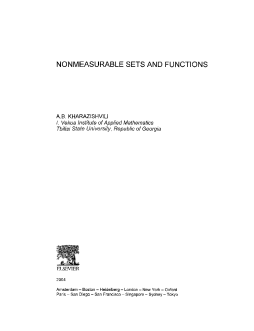
Additional Information
Book Details
Abstract
The book is devoted to various constructions of sets which are nonmeasurable with respect to invariant (more generally, quasi-invariant) measures. Our starting point is the classical Vitali theorem stating the existence of subsets of the real line which are not measurable in the Lebesgue sense. This theorem stimulated the development of the following interesting topics in mathematics:
1. Paradoxical decompositions of sets in finite-dimensional Euclidean spaces;
2. The theory of non-real-valued-measurable cardinals;
3. The theory of invariant (quasi-invariant)
extensions of invariant (quasi-invariant) measures.
These topics are under consideration in the book. The role of nonmeasurable sets (functions) in point set theory and real analysis is underlined and various classes of such sets (functions) are investigated . Among them there are: Vitali sets, Bernstein sets, Sierpinski sets, nontrivial solutions of the Cauchy functional equation, absolutely nonmeasurable sets in uncountable groups, absolutely nonmeasurable additive functions, thick uniform subsets of the plane, small nonmeasurable sets, absolutely negligible sets, etc. The importance of properties of nonmeasurable sets for various aspects of the measure extension problem is shown. It is also demonstrated that there are close relationships between the existence of nonmeasurable sets and some deep questions of axiomatic set theory, infinite combinatorics, set-theoretical topology, general theory of commutative groups. Many open attractive problems are formulated concerning nonmeasurable sets and functions.
· highlights the importance of nonmeasurable sets (functions) for general measure extension problem.
· Deep connections of the topic with set theory, real analysis, infinite combinatorics, group theory and geometry of Euclidean spaces shown and underlined.
· self-contained and accessible for a wide audience of potential readers.
· Each chapter ends with exercises which provide valuable additional information about nonmeasurable sets and functions.
· Numerous open problems and questions.
"The author has done a very good job writing a useful book on a theme which had not previously been described so thoroughly in the literature." Marek Balcerak (Lódz, Poland) in: Mathematical Reviews (2005d: 28001)
